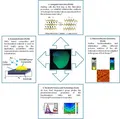| Title: | ATUMS 1-2: Inorganic-organic hybrid photovoltaic solar cells using novel hybrid materials - Optoelectronic Materials |
| Partners: | University of Alberta, Edmonton, Canada & Technische Universität München TUM, Internationale Graduiertenschule für Funktionelle Hybridmaterialen (ATUMS), München, Germany |
| Funding: | funding through Deutsche Forschungsgemeinschaft DFG, Bonn, DFG IRTG 2022 "ATUMS" Project 1-2 |
| Duration: | 2015- |
| Contact: | Professor Dr. Bernhard Rieger, Technische Universität München (TUM), Fakultät für Chemie WACKER-Lehrstuhl für Makromolekulare Chemie, Garching |
| Homepage: | www.makro.ch.tum.de/index.php www.dfg.de/foerderung/programme/listen/projektdetails/index.jsp |
TUM: Peter Müller-Buschbaum, Paolo Lugli, Bernhard Rieger, Martin Stutzmann, Thomas Fässler
UofA: Jillian Buriak, Frank Hegmann, Eric Rivard, Jonathan Veinot
Doctoral Candidates: Michael Giebel, Nuri Hohn
Aim of the project / Overview
The standard of today’s photovoltaics technology is based on crystalline silicon cells. Despite their relatively high efficiencies and long lifetimes these silicon cells face several disadvantages.
Besides complicated and expensive preparation steps and a high demand of material, the mechanical inflexibility limits their possible range of application.
One strategy to overcome these disadvantages is the combination of organic semiconducting materials with inorganic materials in so-called hybrid solar cells.
The advantages are among others the mechanical flexibility, optical transparency and low production costs due to cheap and abundantly available materials and the capability of production on a large scale, e.g. by roll-to-roll printing. At present the realized hybrid solar cells cannot compete with the existing silicon devices. The most challenging task is the improvement of device efficiency and stability of hybrid solar cells.
Hybrid solar cells are typically built-up of an electron-conducting inorganic material and a positive charge carrier-conducting organic material. Based on the well-known system consisting of TiO2 as inorganic component and P3HT as photoactive polymer we aim for improved hybrid solar cell functionality by the use of novel materials. Crucial aspects for good efficiencies are not only well suited organic and inorganic materials but also a perfectly matched morphology of the organic-inorganic interface in the active layer.
In the course of this project we will stepwise improve the organic or the inorganic part separately with respect to novel materials as well as morphology tailoring. In detail beside the conventionally used metal oxides (e.g. TiO2 or ZnO) novel approaches based on non-oxides (e.g. Ge or Si) will be investigated. For the organic component polymers with optimized band gaps and proper aligned band structures in terms of HOMO and LUMO level position will be newly synthesized. Once these new materials are implemented and interfaced with the well-known organic and inorganic component (TiO2 and P3HT) as proof of concept, we aim for double optimized hybrid solar cells with supposed higher device efficiencies.
Additionally the efficiency can be improved via a reduction of light reflections on the surface and increased optical path lengths of light in the photoactive area of the solar cell.
That can be achieved with tailoring the inorganic-organic interface on a larger scale.
Comprehensive material and device characterization is crucial to get a better understanding of the fundamental device function and to draw conclusions between the coherence of device efficiency and material morphologies.
Transport measurements are used to investigate charge carrier mobilities of the fabricated hybrid solar cells under dark and standardized (AM1.5) conditions.
For structure determination of the inner morphology of the devices, scattering techniques (X-rays or neutrons) are used.
Summarized, we aim to improve the power conversion efficiency of hybrid solar cells with the implementation of novel inorganic-organic interface materials.




